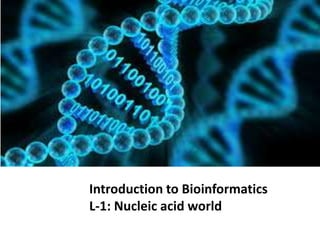Bioinformatics is the interdisciplinary study of biology and computer science. It involves developing tools to analyze large amounts of biological data, such as genetic sequences. There are two main building blocks studied in bioinformatics: nucleic acids like DNA and RNA, and proteins. DNA stores genetic information that is transcribed into RNA, which is then translated into proteins according to the genetic code. Technological advances have led to an explosion of biological data that requires bioinformatics approaches to analyze and interpret.












































